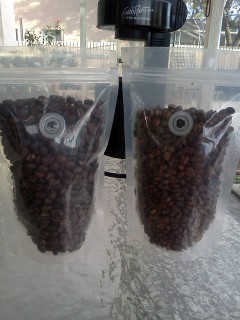
About a year ago, I posted a short video demonstration on how I roasted coffee beans. I also occasionally tweet about some of the beans I roast and attach photos. As I started to mention a few roasting terms, some people suggested I write a post to further explain those terms and the different degrees of roasted coffee beans.
I realized that these people had excellent suggestions and went off and tried to photograph some beans at the different stages of roasting. Unfortunately, my cameras are not up to the job. However, I did find an excellent photograph on the Sweet Maria’s website that details each level of roast exactly. If you would, please click this link while reading this post. I think you will find it very beneficial and will help demonstrate what I am trying to explain.
Coffee beans come in various sizes and shapes but for the most part, they are all a dull shade of green (picture 1). They will also have some amount of a thin, silky, papery covering on them. It comes off the bean during the roasting process as the bean expands and is called “chaff”.
I am not going to mention length of times at these levels since the time will vary from one roaster to another. Basically, there are two different types of roasters: a fluid bed roaster that uses a stream of hot air and a drum roaster that uses heat generated by a flame or an electronic heating element. Professional roasters typically use a gas fired roaster while the home roaster will use one with a heating element or the fluid bed roaster. I personally use a very small fluid bed roaster since I am the only coffee drinker in the house.
Once the beans start roasting, the first change you will see is that they turn a pale green and then turn yellow (photos 2 and 3).
The next change is from yellow to tan (photo 4). At this stage you may also start to smell a bready aroma coming off the beans as they heat up.
As the beans begin to turn brown (photos 5 through 9), I look and listen for the signs of “1st crack”. The beans expand as the water inside them heats up. You will first notice this in the central crack of each bean. As the beans officially enter 1st crack, you will actually be able to hear loud pops as the water vapor is superheated and escapes from the bean. The beans turn brown due to the caramelization of sugars and a process called the Maillard Reaction. The Maillard Reaction is also responsible for the browning of bread crusts and meat.
As 1st crack ends, you can stop the roast. This is officially known as a City Roast. The beans are somewhat smoother looking due to expansion but may still look a bit mottled in color.
The first level past City Roast is City+. The extra time allows for an even bean surface and perhaps a bit deeper color (photo 10).
Full City (photo 11) is the next level and can happen very quickly. The beans are on the verge of “2nd crack”, which is when the cellular structure of a bean starts to break down. You will also hear the cracking sound although it is usually much softer and more rapid. The first “snaps” of 2nd crack are generally considered a Full City+ roast (photo 12).
When 2nd crack is underway, the roast is considered a Vienna or light French roast (photo 13). At this level, the flavors of a bean begin to change, light floral or berry flavors that could indicate a beans origin begin to fade and the flavors of the roast become prevalent.
When the snaps are very rapid, 2nd crack is near the end and the coffee beans are considered to be at Full French Roast (photo 14). The beans are very dark, almost black due to the burning off of sugars. You will also see some of the oils that have migrated to the surface. The beans are beginning to give off a lot of smoke.
Photos 15 and 16 show burnt beans, with the beans in photo 16 ready to burst into flames. In fact, if you dumped those beans into a cooling pan from the roaster, the sudden rush of oxygen would most likely result in fire. In all likelihood, the beans pictured in photos 15 and 16 would not make a good cup of coffee. These beans are mostly carbon with no coffee flavor at all.

